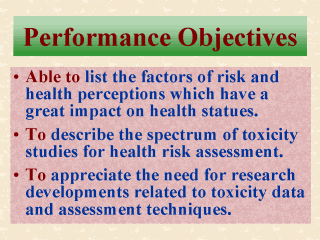| front |1 |2 |3 |4 |5 |6 |7 |8 |9 |10 |11 |12 |13 |14 |15 |16 |17 |18 |19 |20 |21 |22 |23 |24 |25 |review |
 |
At the end of
this lecture, students should be able to list the basic factors that influence our day to
day risk and health perceptions. These perceptions in turn have great impacts on how
health statutes are passed and how health regulatory actions are taken. Many health
protection laws and regulations are enacted in response to public concerns which are based
largely upon the society’s perceptions about heath and risk. From this lecture, students should also be able to outline the spectrum of toxicity studies that are required for the conduct of health risk assessments (RA). Many toxicity studies were conducted long before RA became a regulatory agendum or requirement in health programs. Yet these toxicological investigations did not follow certain accepted study protocols, until after the provision of some guidance documents by regulatory scientists in the United States and overseas, who saw the need for uniform interpretation of toxicity data in performing RA. Finally, students should be able to appreciate the impact of recent advances in assessment techniques and in other related areas, especially those affecting the conduct of toxicity studies and of RA. As an example, the RA performed recently by the U.S. Occupational Safety and Health Administration for methylene chloride was based on an innovative PB-PK model that incorporated both animal and human metabolic data (as mentioned in Lecture 2, Slide 20). |